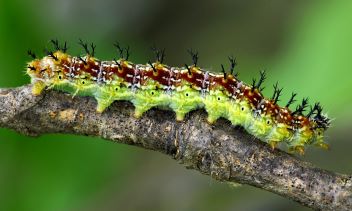
What can we, as Christians, learn from a butterfly’s life? There are many spiritual lessons that can be learned from butterfly metamorphosis. The butterfly’s life cycle offers rich symbolism for Christians, particularly in relation to themes of transformation, resurrection, and new life.
Last year, our homeschool did a Springtime unit study on the butterfly’s life cycle. I have a detailed blog post on The Midnight Toddler that cover the spiritual lessons we learned from butterfly metamorphosis fun facts and activities that you are welcome to check out and use with your kiddos if you are interested.
As we quickly approach Spring this year, we are gearing up to do it again… at the boys’ request. So, while planning to order the Insect Lore Kit from Amazon and develop lessons and activities. I have found myself pondering the Bible study opportunities.
Transformation and New Creation
There are so many spiritual lessons we can learn from butterfly metamorphosis. The dramatic change from caterpillar to butterfly illustrates the concept of spiritual transformation. Just as the caterpillar undergoes a complete metamorphosis, Christians believe they are transformed into “new creations” through faith in Christ (2 Corinthians 5:17 NIV). This process highlights that change, even radical change, is possible and can lead to something beautiful.
The project lasted only three weeks. The first week, we watched hungry caterpillars doing their job – eating. We watched in wonder as they plumped up and practiced climbing to the top of their cup. The closer they got to the chrysalis stage; they began hanging upside down. Conveniently, their bodies would look like the letter J. This was perfect for preschool and kindergarteners, who were learning their letters and pivoted quickly to J for Jesus discussions. We talked about how they didn’t seem to worry about anything. Just as Jesus promised in Matthew 6:25-34 (NIV), their needs were met, and they had everything they needed right there in their cup to transform. If He does that for the tiny caterpillar, we must know He provides for us in spades.

Resurrection and Hope
The chrysalis stage, where the caterpillar appears lifeless, can be seen as a parallel to Christ’s burial. The emergence of the butterfly symbolizes the resurrection, offering hope for eternal life and renewal. It serves as a powerful reminder that even in times of darkness and apparent death, there is the potential for new life and vibrant hope.
When the caterpillars hung their chrysalides, they dangled from the underside of the cup lid. This lends well to discussions and scripture with both young children and teens. In our experiment last year, one of our dangling chrysalides fell. We carefully moved it along with its cup-mates to the mesh enclosure that would be their next lodging.
This opportunity led to a discussion about life and death with the kids, explaining how nature can be unpredictable. We prepared them that not all their butterflies would come out of the chrysalides, especially the one that fell.
The kids held out hope for ten days as their five caterpillars turned to mush and rearranged their bodies within the cocoon they could not see. To our delight, all five emerged as butterflies and lived to their release outside. And the one who fell…who seemed to struggle more than the others, well…that one was the second to emerge. Seeing that the one who did not have an ideal situation after falling not only survived but thrived was a powerful spiritual Lessons about butterfly metamorphosis.
Spiritual Growth
The distinct stages of the butterfly’s life can represent the stages of spiritual growth. Christians can reflect on how they are progressing in their faith journey, moving from one phase to the next. The idea of the cocoon stage can also be seen as a time of being set apart, and growing internally, before being brought forth in a new way.
Our project was about three weeks in total. At the beginning of the project the kids were sad to learn that the butterfly doesn’t live very long. In fact, from egg to reproduction, they only live about a month. After they lay their eggs, the butterfly dies. Once a caterpillar hatches, they eat nonstop until they are ready to make their chrysalides. This means that they chunk up in a record amount of time. For reference, caterpillars eat approximately 27,000 times their body weight during their lifetime.
That level of growth shows us that we can grow in the Word. Imagine if we savored the scripture the same way caterpillars take in leaves.
2 Corinthians 3:18 (NIV) says, “And we all, who with unveiled faces contemplate the Lord’s glory, are being transformed into his image with ever-increasing glory, which comes from the Lord, who is the Spirit.” Our growth leads us to change into something better. The caterpillar’s growth to butterfly is a palpable image for what that looks like, exhibiting one of many spiritual lessons we can learn from butterfly metamorphosis.

Endurance and Perseverance
The process of transformation is not always easy. James 1:12 (NIV) says, “Blessed is the one who perseveres under trial because, having stood the test, that person will receive the crown of life that the Lord has promised to those who love him.” The caterpillar’s struggle to emerge from the chrysalis can symbolize the challenges and trials that Christians face. It emphasizes the importance of perseverance and trusting in God’s plan, even during challenging times.
We watched those caterpillars eat, climb, shed their skin, and repeat for three weeks. They started off so tiny, grew, and never seemed bothered by falling; never looked around and compared themselves to each other, and never stopped moving.
I imagine shedding an exoskeleton may be an uncomfortable and time-consuming venture for such a tiny creature. What’s more, is that they do it five times before they are ready to go into the chrysalis. This was a visual aid like no other for the children to see the payoff of going through hard things, and that blessings come from endurance and perseverance.
The Ultimate Metaphor
I think it is important to remember that much of the transformation a caterpillar goes through on the way to becoming a butterfly is unseen. Scripture speaks to this in Romans 1:20 (NIV). The Apostle Paul reminds us that “since the creation of the world God’s invisible qualities—his eternal power and divine nature—have been clearly seen, being understood from what has been made, so that people are without excuse.”
The butterfly’s life cycle is a beautiful and tangible metaphor for the Christian journey of faith, hope, and transformation. For parents, it further symbolizes that we need not have fear on this journey.
These little critters can teach us that even in times of darkness and apparent death, there is the potential for new life and vibrant hope.

















